If you want food security, think potatoes
There's probably no other crop that's so easy to grow productively in so many different climates and conditions. History reveals just how vital the potato has been to humankind - and how important it is to our future.
Potatoes are native to the Andes region - the South American mountain range that stretches 5,500 miles and reaches heights of 22,000 feet. The local populations have cultivated literally thousands of different potato varieties since before the time of Christ. It was a staple of the native Andeans for millennium, and a staple that helped sustain the Inca empire for centuries.
Dozens of different varieties can be found within just a few miles of each other. A variety grown in one village can look and taste completely different from another grown just a few miles away. Of the estimated 4,000 different potato varieties in existence, the vast majority of them originated in the Andes.
Given the success of the potato in the Andes, you'd think that the
region has plenty of good land ideal for growing crops. But in fact, the
opposite is true. There's far less arable land in the Andes than many
other countries ... and yet potatoes thrive. They grow well even when
arable land is limited. They grow in varied climates and at varied
altitudes. They grow in harsher climates, and many varieties are drought
tolerant. But despite those conditions, a potato plant provides more
food than any other staple crop: 85% of the plant is edible, compared to
50% of a cereal grain plant.
The Incas introduced the potato to the Spanish conquistadors. The
Spanish, in turn, introduced the potato to Europe. It was a tough sell
at first. Europeans were afraid it was poisonous or that it caused
leprosy and disease. Eventually, though, it changed the course of
history. Here's why:
Once the potato caught on,
Europe had true food security for the first time in
millennia.
In the 1500s in Europe, grain farmers typically let at least a third (and often half) of their land lie fallow each year. It was smart land stewardship, but it came at a price; history records widespread famines during the centuries when so much land laid fallow. One historian, Fernand Braudel, reported that for over 200 years, there were at least 40 nationwide famines across France. In a 100-year period (1523-1623), England suffered 17 major famines. Millions of people starved to death.
And then came the potato. Farmers began putting potatoes into rotation on formerly fallow fields. The potatoes produced 70% more edible food per acre than grains ... and widespread famines all but disappeared (until the 1840s, when dependence on a single variety, the "lumper," brought famine to Ireland.)
The potato's importance to the labor class from 1500 to 1800 is impossible to overemphasize. It changed life completely for the peasants.
Why Potatoes Have Stood the Test of Time
Put yourself in the shoes of a 17th century European farmer. You're
doing manual labor all day. Farming is backbreaking work. Any innovation
that saves you time or energy, any innovation that gives you more food
for less work, is welcome ... and the potato fits that bill. Potatoes
are easy to grow--much easier than wheat or barley.
Potatoes don't need much coddling; you just dig a hole, drop them in, and cover them with dirt. As they grow, you pile a little more dirt around them. The weeds can be controlled with a little judicious hoeing. If you want a tender delicacy that will fetch top price at the market, you harvest potatoes when they're young and small. But if you want volume, leave them in the ground longer and they'll grow bigger. They tolerate all different climates, all different altitudes, and aren't nearly as "needy" as the other plants in your garden. No wonder peasant farmers loved potatoes.
Today, they're equally as valuable to people with limited space, time, and energy.
If you have limited yard space, just keep on hilling the dirt throughout the season, and you'll have potatoes growing in a long, vertical configuration. The same vertical growing principles apply even if you don't have a yard. You can grow them in boxes, barrels, and even stacked up old tires (although we don't recommend the latter, as chemicals from the tires may leach into the soil).
Potatoes are a great crop for beginning gardeners. They're hard to mess up. If you need to produce volume and calories for your family (not to mention taste and nutrition), potatoes are a no-brainer.
Potatoes can stretch every meal. Potatoes can be the meal. But don't let their humble nature fool you - because they can be every bit as "gourmet" as some of the most exotic vegetables on the planet.
25% Off All Potatoes ... While They Last
If you're going to get potatoes in the ground for this year's garden, now is the time. And to give you a nudge, we're offering all our potatoes at a whopping 25% off. But act now, because supplies are limited. Simply enter coupon code POTATOES. Don't put all your eggs in one basket, and don't put just one variety of potatoes in your garden. (Remember the Irish?) We have eight delicious varieties for you to choose from:
ALL BLUE
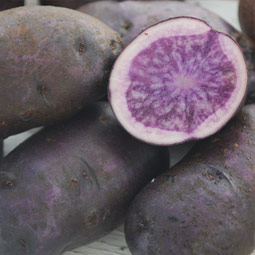 In
our opinion, this potato's outstanding flavor and moist texture make it
the best blue potato available. Roast 'em, fry 'em, or make colorful
blue chips. This potato has exceptionally high mineral content, plus the
blue pigment confers the valuable antioxidant called anthocyanin
normally found only in dark berries. This variety keeps well, too. If
you're looking for a different and satisfying potato dish, try this:
roast the smaller ones until they are soft on the inside. Crush them
until they split open, drizzle on the melted butter, and top with
chopped garlic and fresh herbs.
In
our opinion, this potato's outstanding flavor and moist texture make it
the best blue potato available. Roast 'em, fry 'em, or make colorful
blue chips. This potato has exceptionally high mineral content, plus the
blue pigment confers the valuable antioxidant called anthocyanin
normally found only in dark berries. This variety keeps well, too. If
you're looking for a different and satisfying potato dish, try this:
roast the smaller ones until they are soft on the inside. Crush them
until they split open, drizzle on the melted butter, and top with
chopped garlic and fresh herbs.
DESIREE
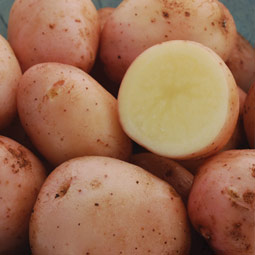
First introduced from the Netherlands in 1962, it's become a "must-have"
in our garden. It's a great all-purpose potato; we think it's the best
red-skinned, golden-fleshed potato found anywhere. Naturally drought
resistant, too. For an easy side dish, cube this potato, toss with fresh
rosemary, crushed garlic, and olive oil, and roast alongside the main
dish.
BINTJE
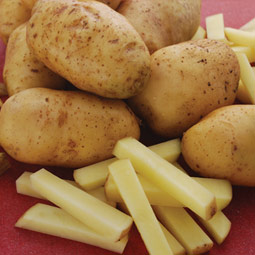
Bintje grows in a wide range of soil types and stores well; no wonder it
fed the Belgians through two world wars and is one of the most widely
grown yellow-fleshed potatoes. Hands down the best variety for French
fries; this is the potato that made Belgium famous for them. (The secret
to perfect home fries with Bintje? Steam first, then sauté.) It's well
suited for roasting, too, and makes scrumptious scalloped potatoes.
GERMAN BUTTERBALL

This excellent all-purpose variety is good for roasting, frying, and
especially for mashing. No wonder it was a first place winner in
Rodale's Organic Gardening "Taste Off." It does well in long-term
storage so don't be afraid to plant plenty! The slightly nutty, buttery
flavor takes traditional dishes like potato soup or potato latkes to a
whole new level.
PURPLE VIKING
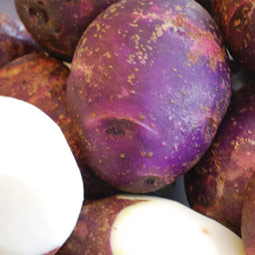 A
good choice for a general all-purpose potato. Under ideal conditions,
this variety can get quite large. Picked early, Purple Vikings are
delicious new potatoes with a delicate flavor. Suitable for all types of
preparation, the snowy white flesh makes it exceptionally good for
mashing. To fully enjoy the Purple Viking's color and nutrients, scrub
well and leave the skin on; "smash"instead of "mash" them. They store
well, so you can keep enjoying them long after harvest.
A
good choice for a general all-purpose potato. Under ideal conditions,
this variety can get quite large. Picked early, Purple Vikings are
delicious new potatoes with a delicate flavor. Suitable for all types of
preparation, the snowy white flesh makes it exceptionally good for
mashing. To fully enjoy the Purple Viking's color and nutrients, scrub
well and leave the skin on; "smash"instead of "mash" them. They store
well, so you can keep enjoying them long after harvest.
LA RATTE
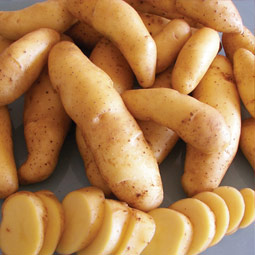 This
top quality French variety is hard to find in stores, but highly prized
by chefs and gourmands everywhere. Great for boiling, roasting, and
frying, with a smooth buttery texture and unique nutty flavor. Give this
the right growing conditions and you'll enjoy abundant yields. Busy
cooks appreciate their thin skin because it makes peeling unnecessary;
just give them a quick scrub. La Ratte's texture and flavor make potato
salad easy; after cooking, chill La Ratte potatoes, cube them and toss
with mayo, a little diced onion, and fresh dill.
This
top quality French variety is hard to find in stores, but highly prized
by chefs and gourmands everywhere. Great for boiling, roasting, and
frying, with a smooth buttery texture and unique nutty flavor. Give this
the right growing conditions and you'll enjoy abundant yields. Busy
cooks appreciate their thin skin because it makes peeling unnecessary;
just give them a quick scrub. La Ratte's texture and flavor make potato
salad easy; after cooking, chill La Ratte potatoes, cube them and toss
with mayo, a little diced onion, and fresh dill.
ROSE FINN APPLE
 An
excellent choice for potato salad, steaming, frying, boiling, or
roasting. The exceptional waxy texture means this fingerling holds its
shape very well. Rose Finn Apple is a good keeper, so you can still
enjoy it long after harvest. On a cold autumn day, oven roast this
variety with olive oil, sprinkle with parmesan or fresh herbs, and add a
dab or two of sour cream. (You'll wish you made more.)
An
excellent choice for potato salad, steaming, frying, boiling, or
roasting. The exceptional waxy texture means this fingerling holds its
shape very well. Rose Finn Apple is a good keeper, so you can still
enjoy it long after harvest. On a cold autumn day, oven roast this
variety with olive oil, sprinkle with parmesan or fresh herbs, and add a
dab or two of sour cream. (You'll wish you made more.)
YUKON GOLD
 This
Canadian variety was first introduced in 1966 and has since become one
of the most widely grown specialty potatoes. And no wonder--it matures
early, and produces abundant yields. A truly all-purpose potato for
baking, frying, mashing, or salads. Stores well, too. Try this with your
Yukon Golds: cook until soft, then mash with roasted garlic, caramelized
onions, a little fresh cream, a bit of butter, and a dash of salt.
This
Canadian variety was first introduced in 1966 and has since become one
of the most widely grown specialty potatoes. And no wonder--it matures
early, and produces abundant yields. A truly all-purpose potato for
baking, frying, mashing, or salads. Stores well, too. Try this with your
Yukon Golds: cook until soft, then mash with roasted garlic, caramelized
onions, a little fresh cream, a bit of butter, and a dash of salt.
Potato supplies are limited. Act now.
>>>
Click here to order your potatoes today.
To get them at 25% off, enter coupon code
POTATOES. <<<
Solutions From Science
815 W. Main St.
P.O. Box 518
Thomson, IL 61285
Email us at info@solutionsfromscience.com